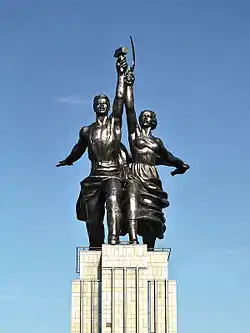Soviet people
Soviet people (Russian: Сове́тский наро́д, tr. Sovyétsky naród ) or citizens of the USSR (Russian: Гра́ждане СССР, tr. Grázhdanye SSSR ) was an umbrella demonym (politonym) for the population of the Soviet Union.
| Part of a series on the |
| Culture of the Soviet Union |
|---|
 |
| People |
| Languages |
| Traditions |
| Cuisine |
| Festivals |
| Literature |
| Sport |
|
Nationality politics in the early Soviet Union
.jpg.webp)
Through the history of the Soviet Union, both doctrine and practice on ethnic distinctions within the Soviet population varied over time. Minority national cultures were not completely abolished in the Soviet Union. The Soviet definition had national cultures to be "socialist by content and national by form" and used to promote the official aims and values of the state. The goal was always to cement the nationalities together in a common state structure, but as a pragmatic step in the 1920s and the early 1930s under the policy of korenizatsiya (indigenisation), the leaders of the Communist Party promoted federalism and the strengthening of non-Russian languages and cultures (see national delimitation in the Soviet Union). By the late 1930s, however, the policy shifted to more active promotion of the Russian language and later to more overt Russification efforts, which accelerated in the 1950s, especially in Soviet education. Although some assimilation occurred, that effort did not succeed on the whole, as was evidenced by developments in many national cultures in the territory after the 1991 dissolution of the Soviet Union.[1]
See also
- Demographics of the Soviet Union
- Homo Sovieticus
- Melting pot
- New Soviet man
- Orthodoxy, Autocracy, and Nationality
- Rootless cosmopolitan
- Russification
- Zhonghua minzu, the equivalent notion in the People's Republic of China
- Yugoslavs
References
- Anderson, Barbara A.; Silver, Brian D. (2019). "Some Factors in the Linguistic and Ethnic Russification of Soviet Nationalities: Is Everyone Becoming Russian?". In Hajda, Lubomyr; Beissinger, Mark (eds.). The Nationality Factor in Soviet Politics and Society. Routledge. pp. 95–130. ISBN 9781000303766.